There’s hardly a harder point in a writer’s life than to find what to write about.
You have many ideas, but you can’t seem to escape the blank page. It stares at you, and you can’t put words in there, even though you’re full of ideas.
If you want to discover how to find fun, interesting, and cool ideas to write about, this article is for you.
I will show you five tactics I’ve used to develop content every day consistently. Forget the headaches; these tactics are easy to implement and will ease your life, just like they did for mine.
Let’s get started.
🎁 Warning: This article is 5,008 words long. Download the summarized version with the exact steps to learn how to find what things to write about.
A Great Topic to Write About: Your Brand
You may not realize this, but you have a brand.
Whether it’s a personal brand, a blog brand, or a company brand, you have an identity that represents you in front of your audience. It’s what makes your company unique and special.
Your brand represents an idea, a mission, or a purpose. It’s the promise you make your visitors as soon as they hit your site.
Your brand is a good topic to write about as long as your brand’s promise helps your customer in any way.
Take the case of Content Fiesta: the brand represents the content writers who want to write authoritative content that attracts eyeballs and business inquiries; it helps writers go from amateur bloggers to professional content creators who can make a living from their craft.
Here, you can expect to learn everything that comes out of that mission, whether that’s to improve your writing skills, learn marketing, master the art of content promotion, and more.
Because I have a clear idea of what my brand represents, I can define an almost unlimited set of topics to write about. It’s easy; too easy, I’d say.
Define What Your Brand Is About
The first step to finding what to write about then it’s to know what your brand is about.
- If you work for a business, check its missions, vision, and values
- If you work independently, think of the reason why you want to help your clients succeed
- If you write for yourself, think of the reason why you write
Whenever I’m not sure what to write for Foundr, one of my best content marketing consulting clients, I go to their about page and remember why they exist: to help entrepreneurs start and grow their business.
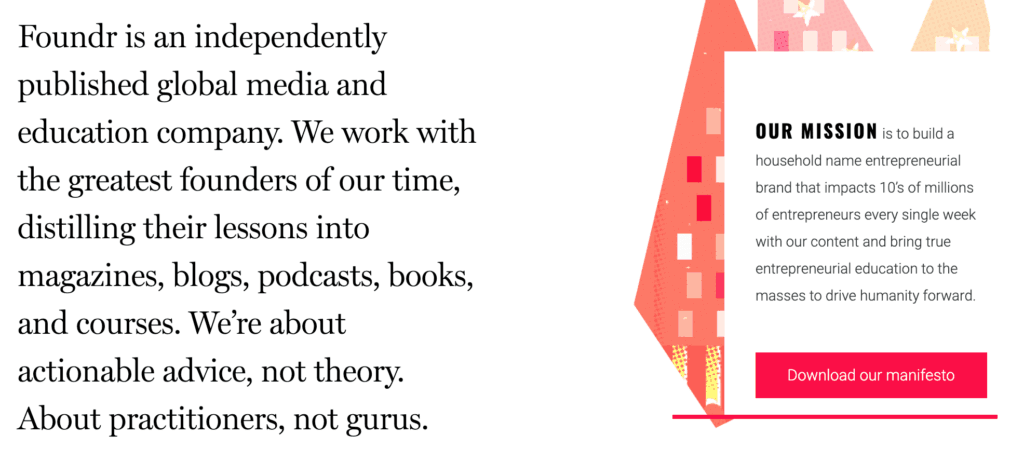
With that single idea, I know how to position most of my pieces and what types of ideas to come up with.
There will never be a definitive answer to any of the previous points. Brands, just like your personal identity, change. You learn and you grow, and so the values that make you a unique human being. The point is to find the most important values you (or your company) has and take those points as guiding principles.
Based on the brand you represent, you then need to within to uncover the ideas that fulfill its expectations. You need to write based on the identity that makes your company unique.
If Content Fiesta’s promise is to help content creators develop authoritative content and help them attract traffic to it, then any topic that doesn’t fulfill such expectations can’t make it to the blog.
(Note that some of my old content doesn’t fit well with these expectations because a few years back I was more interested in other topics than just writing and content promotion. As I said, brands change. 🤷♂️)
It’s not enough to write only about what you want to write about—that’s what blogging 1.0 was all about.
Instead, start with a clear idea of your brand, and from there, brainstorm a list of potential ideas to write about.
At the least, your brand will give you a good starting point and a good filter from all the ideas you will come up with later on.
Get Inside Your Audience’s Mind
Your audience is the ultimate source of inspiration, bar none. If you want to get an unlimited stream of ideas to write about, then you need to research your audience.
Or, as I like to say, you need to become a master mind reader.
In this context, “your audience” can mean the actual people who have signed up for your email list or followed you in your social media accounts (the “owned media,” as marketers call it) or the people who belong to your ideal customer profile but haven’t visited your site yet or haven’t signed up for your email list.
Consequently, let’s separate your audience research into two parts:
- Analyzing your current audience.
- Analyzing your potential audience.
Research Your Current Audience
The fact you have people who have indicated they want to learn more from you means you’ve already connected with them. You’ve “clicked;” they’re your friends, now you only need to get to know them.
The best way to research your current audience is to use a survey.
First, you need to define the key points you want to uncover. In our case, you want content ideas, but to get them, you need to get to the core question or problem that your content will solve.
You could ask “what topics do you want me to write about?” but not only that’s lazy, it’s also ineffective.
People rarely know what they want—not because they’re not smart, but because people can rarely know the deep issue that makes them want something.
I can tell you I like to write a lot because it makes me feel good, but the real reason why I write is because I like expressing myself. That’s my deep reason, and you won’t get such an answer if you ask me “why do you like to write?”
Ask lazy questions, and you will get lazy answers.
Some of the best ways I’ve found that you can ask to uncover such deep problems and needs are:
- What’s your #1 challenge?
- If you could have a magic wand that could change one aspect of your life, what would it be?
- What’s causing the biggest discomfort in your life right now?
With such questions defined, you then need to create the survey. My favorite tools are Typeform and Qualaroo, both of which make your surveys look awesome. You can also connect it with Google Sheets and get your answers in there as they go, which makes your analysis easier.
Then, send the email and promote the message in your social media accounts but only to your followers.
Since you’re doing qualitative analysis, you don’t need to get a minimum threshold of responses. No need for statistics, fortunately. 🙏
The more answers you get, the better. You will have a better idea of the big issues your audience has. But if you only get a dozen or so responses, it’s still better than nothing. Most people and companies rarely survey their audiences.
You can also read your audience’s mind by reading:
- The comments they’ve given you in your posts.
- The messages they send you in your social media accounts.
- The emails they send you.
In many cases, they will ask you to talk about a certain topic dear to them in any of those ways. That’s the lowest hanging fruit you have at your disposal; if people talk to you and ask you questions, then take them seriously. They’re opening themselves to you, you only need to listen to them.
Take a look at the following comment from Foundr:
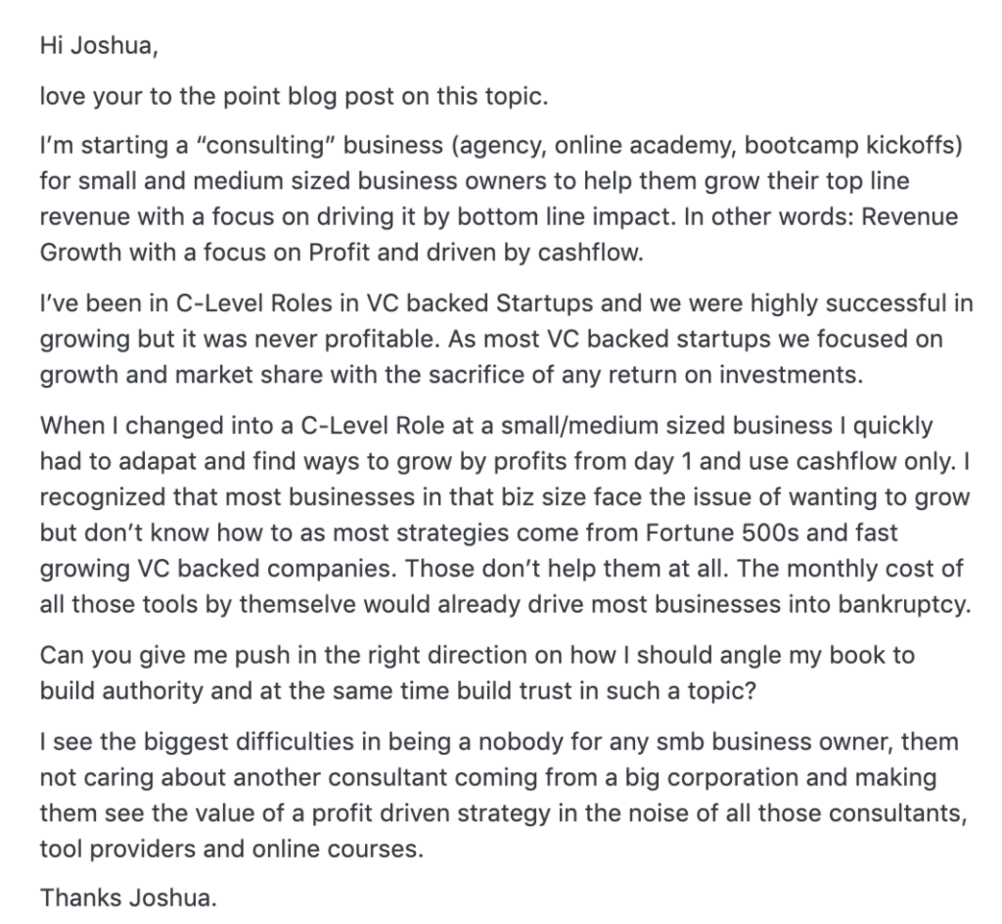
Such comment is truly eye-opening; a reader opening to you like this is a wonderful opportunity not only to connect with one potential life-long fan but to get to know your readers as well.
Or take this simple example from Twitter:
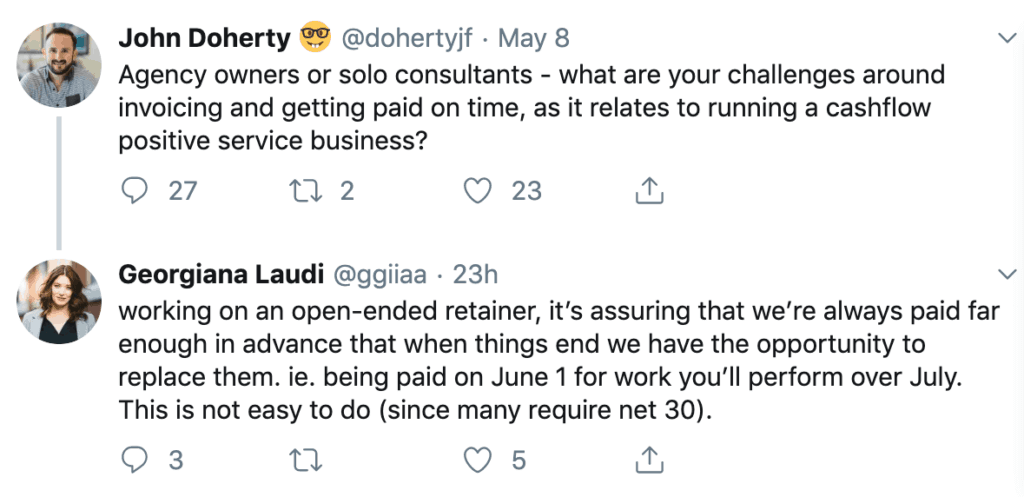
These types of online conversations are great opportunities to get to know your audience without much effort. What’s more, the comments will be as original and pure as you can get them.
Research Your Potential Audience
Regardless of your audience size, there will always be more people outside your following, so you need to get out and see what they talk about.
As the saying goes “marketers ruin everything,” so you don’t want to get out with a marketer’s hat asking questions; rather, you want to see what they talk about without them knowing you’re observing them.
You’re like the narrator in National Geographic’s documentaries—you’re observing them and learning from their actual behaviors and words.
Two of my favorite ways to research a potential audience are checking:
- Facebook groups comments.
- Twitter feeds.
In each and every site, you need to start searching for keywords that best represent your audience.
Facebook Research
If I was researching writers, I’d get on Facebook and search for “writing,” a broad keyword that’d show me lots of mostly irrelevant results. From there, I’d click on the “Groups” tab so I can get narrower (and better) results.
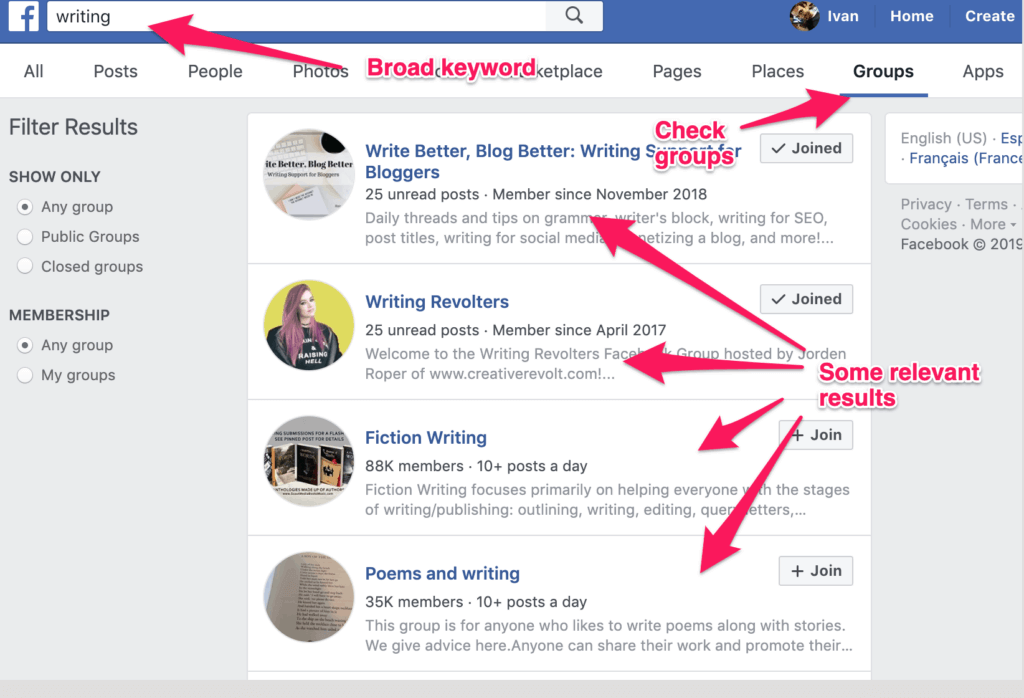
The first two groups (of which not I’m already a part) are relevant for my needs, while the latter two aren’t.
What I’d do then is open both groups and check the questions asked, and the comments people make.
In the first group, for example, I found the following question:
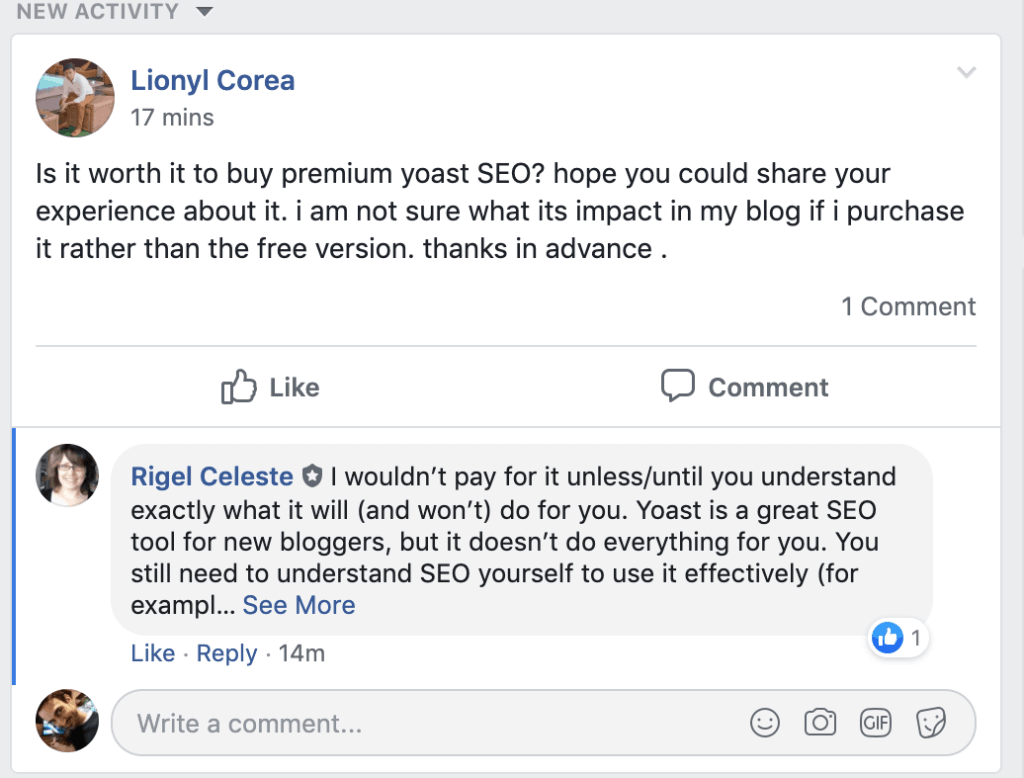
I’d have not expected to find that question in a writing group, but it clearly is an existing problem that this audience needs help with, so I could easily write an article talking about whether it makes sense to pay for Yoast’s premium plugin (short answer: it does).
Twitter Research
On Twitter, it’s a bit trickier to research people. The best way I believe it’s to find influencers—people with lots of followers and high engagement—and see what they write and share, and what people tweet back at them.
To find influencers and conversations, I’d start with a broad search, like “Content writer,” and check the results I find.
Finding the right people takes a lot of wandering around the results to find specific accounts with high degrees of engagement.
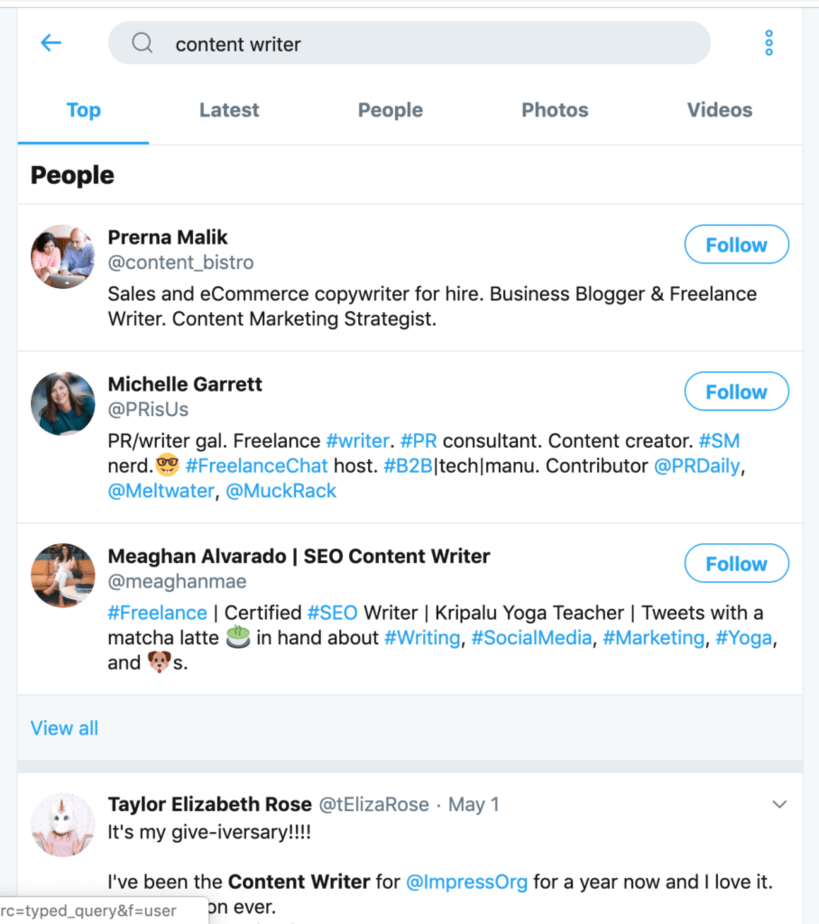
In this example, the first user (@content_bistro) wasn’t too useful, so I moved on to the second user (@PRisUs), who showed me that there’s a chat called #FreelanceChat which I can use to dig deeper into the freelance audience.
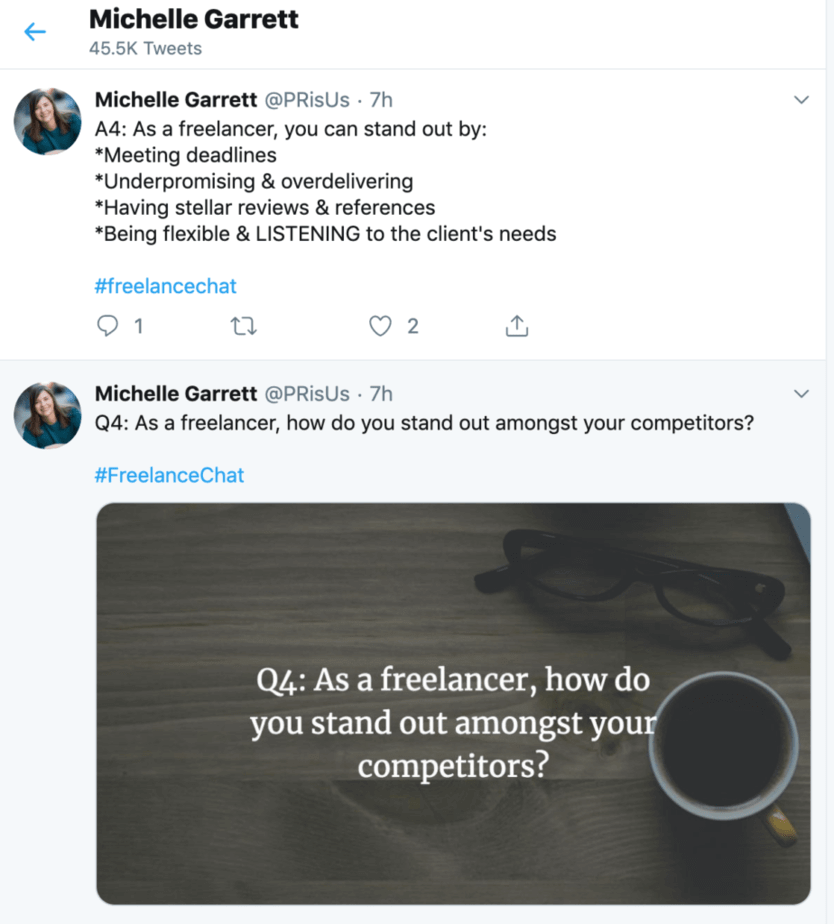
In here I was able to find some gold nuggets, like the following one:
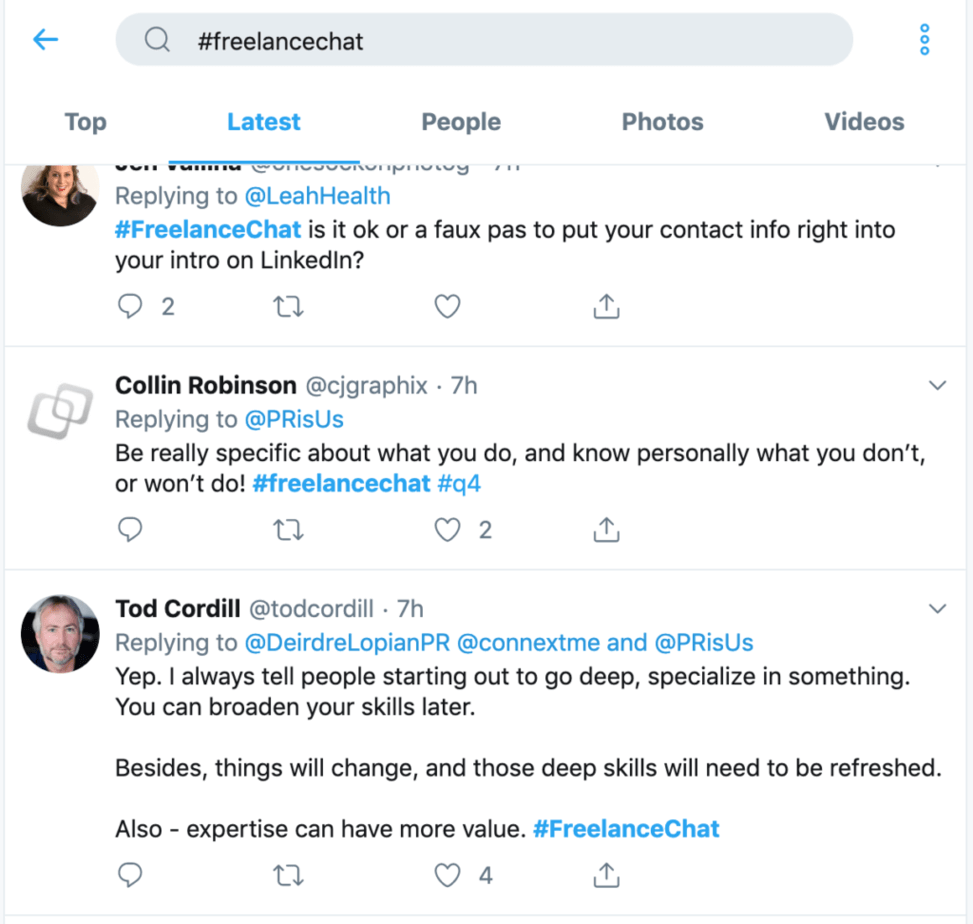
In this chat I can become much more ingrained with the thought processes of freelancers (the people who make up this “chat”). I can learn a lot about the ways freelancer’s think, their belief system, and their values, something that’s of great importance in any research project.
Some other more time-consuming but equally effective ways to research your potential audience include:
- Listening to people talk in events, including the name of the talks and words used in them.
- Interviewing people.
- Sending surveys to Facebook groups and forums.
- Checking what experts and influencers say, including expressions and words they repeat over and over.
Whatever way you choose, it’s paramount you read between the lines. Just as I said before you can’t ask people what they want, you can’t take everything they say at face value.
Your job is to find the subtleties beneath the surface—the beliefs, the thought patterns, the shared values, and the common challenges faced.
For example, in the sales community, new accounts are often seen as something we won over. You “close accounts” or you “win accounts;” those expressions make you realize salespeople often have a very macho attitude towards life, as if they were cavaliers fighting dragons.
Your audience will never tell you what they want; they will tell you who they are, what they believe in, and what they expect.
It’s your job to uncover those aspects. From those discoveries, you will be able to come up with amazing topics that will speak to your audience’s hearts and spirits.
🎁 Want to read the rest later? Download the summarized version with the exact steps to learn how to find what things to write about.
Research Your Market’s Pains and Interests
The market in which you or your company operates speaks for itself whenever people in it search for information, share content, or praise a given piece of content.
While your audience, as you’ve seen in the previous section, talk about specifics problems, the market talks in trends and interests.
Whenever someone shares a piece of content, makes a Google search, or asks a question about a given topic, that shows there’s interest about a topic that can help you find potential ideas for writing. More importantly, it shows their pains and troubles which, not surprisingly, you can use to fuel your content.
Let’s take this piece by piece, starting with my favorite market research tactic.
Analyze Your Market’s Keywords
SEO specialists love to talk about keywords because they show people’s interests; something that they use to attract traffic to a page.
For example, if a set of people search for “email automation software,” it means people want to learn more about that topic. If you happen to be in that market, then all the people who search for that keyword are your potential visitors (and customers).
But that idea that keywords equal potential visitors misses a key point:
The keywords people use in a market don’t just represent a need for information; the keywords also imply these people who use them have a problem, a question, or a pain.
Keywords are proxies for problems.
Once you understand that, you can use keywords as a mechanism to uncover the problems your audience has.
Your job then is to find the keywords your audience uses and then think deeply what’s the problem that’s causing someone to use it as a search query.
Let’s say you were in the fitness industry, and you found the keyword “hip exercises:”
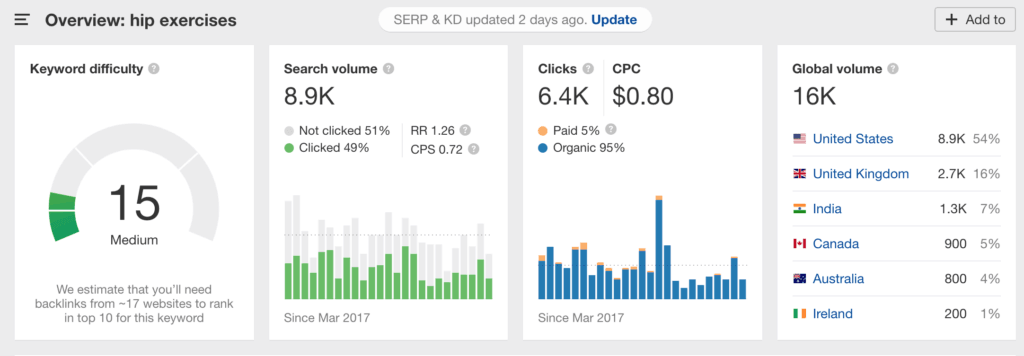
If you took the advice from most SEO experts, you’d start churning out content with tips, advice, and exercises to improve the hip…but, you’d be missing the point.
Why would anyone search for the keyword “hip exercises”? Just because they’re bored? Because they randomly like exercising their hips?
No, people who search for hip exercises have a problem in their hip. Do young people tend to have hip problems? No. Do people who want to improve the firmness of their butts use them? No, they use “butt exercises” (seriously, search for that keyword and see the results that show up).
The people who search for that keyword are old people who want to improve their hip mobility and strength.
If you kept searching, you’d actually find the keyword “hip pain” has even many more searches than “hip exercises.”
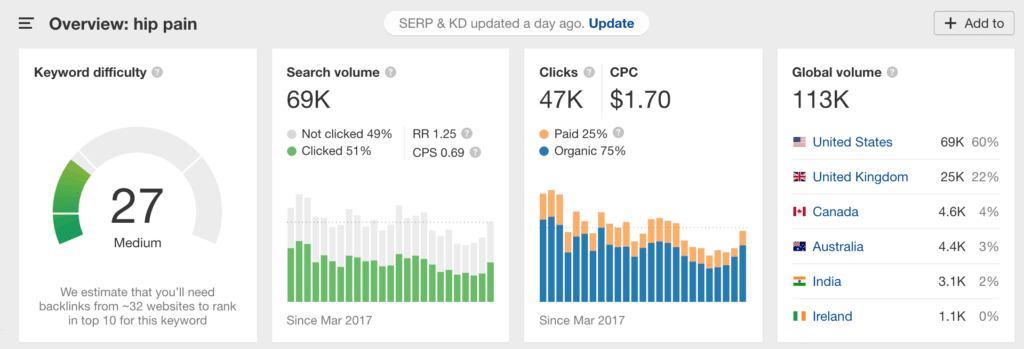
While they’re two different keywords, they speak to the same problem. First you look for explanations for the problems in your hips, then you search for exercises to fix them.
From this insight, you can start creating multiple guides to solve the actual problem that leads people to search for hip exercises.
Of course, if the keywords you analyze included words like “challenges,” “problems,” or “pains,” it’s obvious they’re problems.
But more often than not, they’re not so obvious and you need to go deeper, as I just showed up.
The Best Tools for Finding Keywords
My favorite keyword research tool is to use Ahrefs. Not only it’s the best keyword research tool, but it also comes with an amazing content explorer that shows you the content people share on Facebook, Twitter, LinkedIn, and Pinterest.
Another great tool I love to use is Keywords Everywhere. It leverages Google Keyword Planner’s data, so their search volumes and CPCs are trustworthy. They are also extremely cheap, charging $10 for 100,000 searches—basically nothing. Since it’s a browser extension, all you have to do is install it, get their API, and start searching as usual.
Both ahrefs and Keywords Everywhere are a fantastic 1-2 combo punch for your keyword search needs.
Check the Questions People Ask
What’s the goal of a question?
On the simplest terms, it’s to get an answer to a problem.
Therefore, if you find the questions people ask within your industry, you can find the problems they face.
In the online world, two of the best places to find questions people have are Reddit and Quora.
Quora is a site for questions and answers, so finding questions there is dead easy.
For example, let’s say we were looking for questions on improving grammar mistakes. Here’s what we’d find:
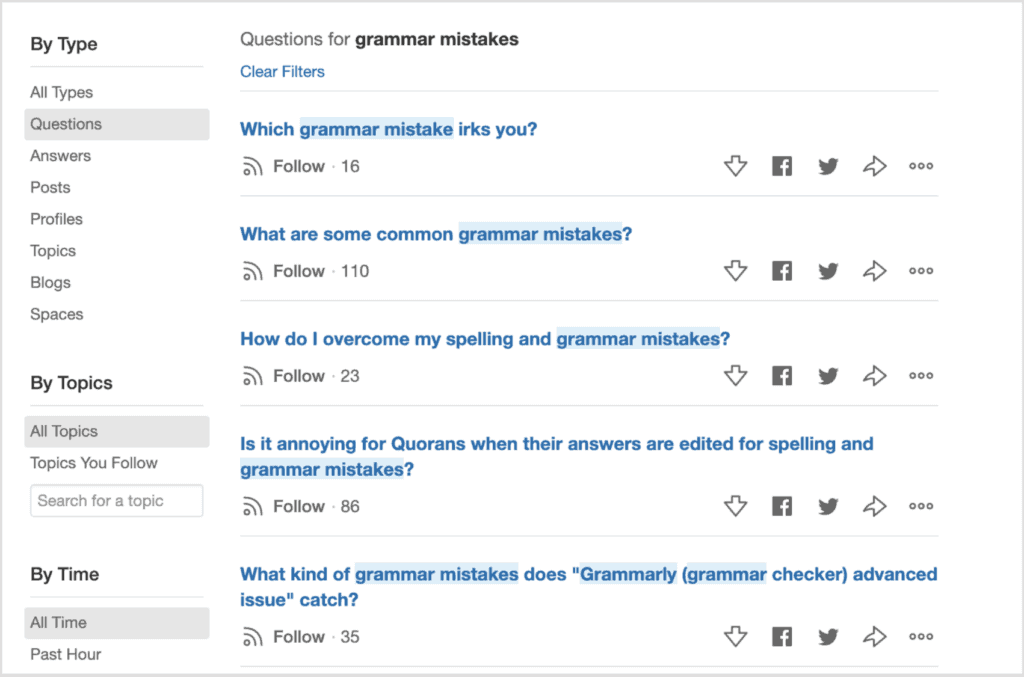
The idea isn’t to search what people comment, but just to get an idea of the questions asked and their popularity.
Assuming that the more questions you find repeated, and the more upvotes and followers one question has, the more pressing the question is. Such finding is key to uncover the deepest pains and problems a given audience has around a topic.
In Reddit, questions can be a bit more indirect to find but equally valuable as the ones from Quora.
Continuing with the previous example, let’s search for grammar mistakes in Reddit.
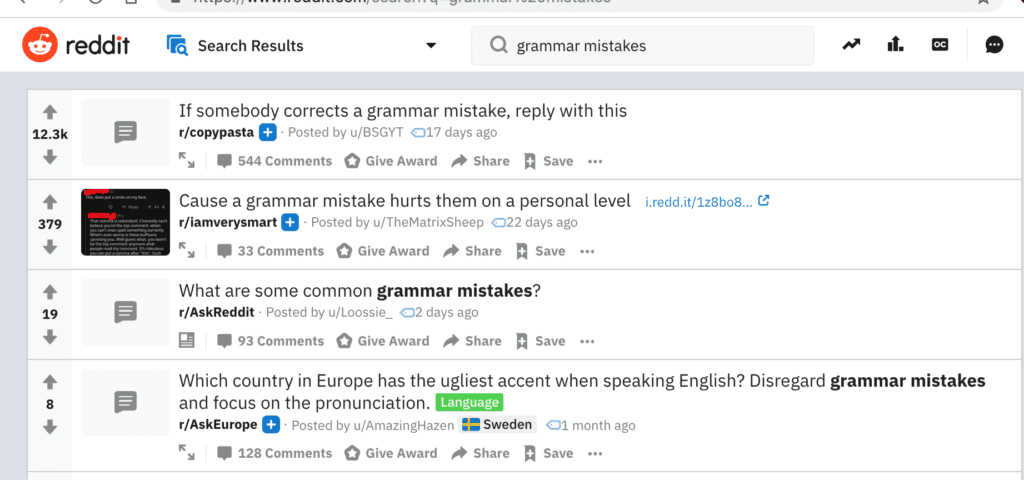
Honestly, these results aren’t too good. In this case, you can try with other queries until you find something that seems to be talked a lot about.
If you want to take a more indirect approach, you can also check Reddit’s most popular posts in your industry’s subreddit.
Continuing with the previous example, then the “/r/grammar” subreddit is the best:
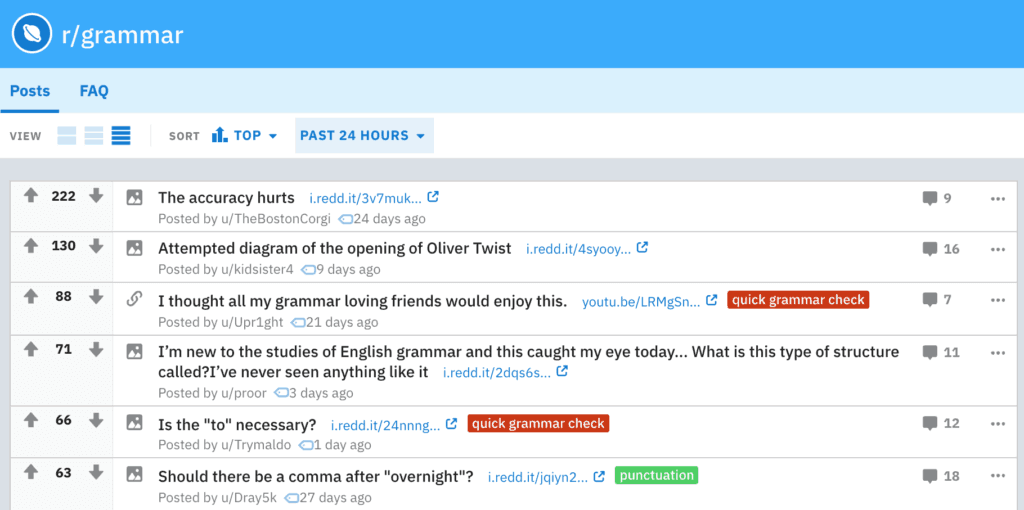
Before you analyze anything, organize the comments by “Top” and from the past 30 days or past year.
Your job is to go through the results to find common patterns, like common questions or comments.
The research I’m showing you is painstakingly slow and detailed, but if you take the time to do it, you will find key insights few people will know about, something that will help you connect with your audience in a deeper level.
Keep an Eye of Trends with Google Trends
Most problems and questions people have don’t come out of thin air; they grow progressively. That’s how trends are born, grow, and eventually fade out.
The best tool to find trends is Google Trends.

Often overlooked, Google Trends is a wonderful tool that helps you compare the popularity and trend searches of topics people search.
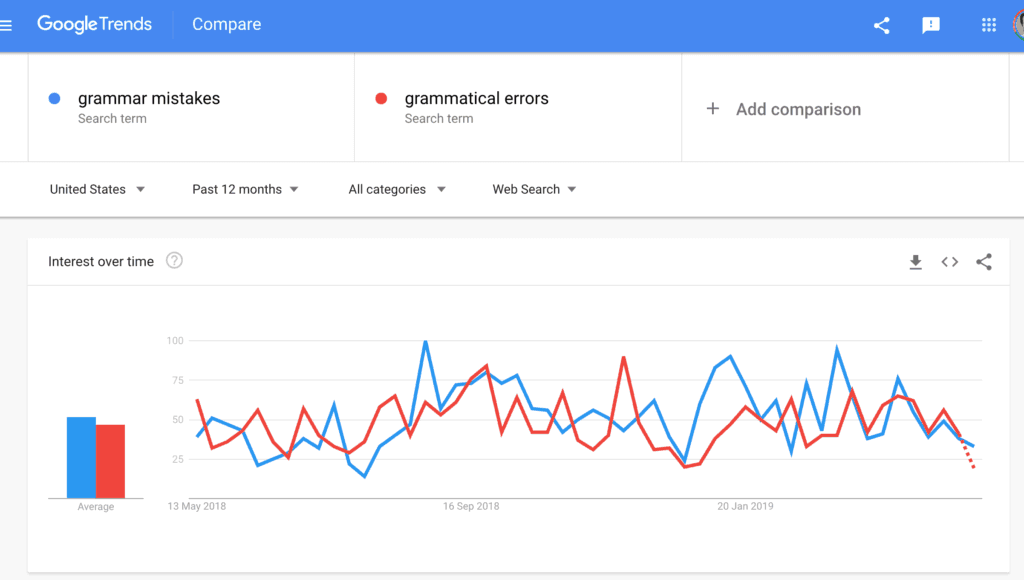
Google Trends isn’t a keyword research tool like Google Keyword Planner where you add a keyword and then you wait for the tool to tell you the specific search volumes.
Rather, it’s a tool that tells you which topics are popular compared to other similar ones, and how they’ve progressed over time.
The key to using Google Trends is to ignore the specific numbers it gives you—whether a keyword has an interest of 30 or 80 doesn’t make a difference—and focus on the trends.
Don’t think of it as a keyword research tool; only as a trend measuring tool. If there’s a topic that’s suddenly growing in popularity—like the release of a new product or technology—then search for it and see how it’s growing compared with other similar topics.
If you can smell the trends and find the “blue ocean” where you can become the number one at it, you’ll be able to find amazing ideas.
Check Your Competitors
It’s no secret that your competitors are a great source of inspiration.
Check any keyword research guide, and in all of them you will see that the writer talks about “competitive research.”
The reason for that is simple: your competitors—many of whom have more resources than you—have already done much of the grunt work for you and have done their keyword research.
If you reverse engineer the keywords for which they rank, you will uncover a lot of great ideas without any effort.
That’s a great tactic…up to a point.
The idea of researching your competitors isn’t to do exactly what they do—they have different brands, different goals, offers, and most importantly, resources.
The key to competitive research is only to get inspiration—nothing more.
The goal of analyzing your competitor’s work is to source different sets of ideas—whether they’re keywords, content pieces, or marketing tactics—and check them against your own goals, offers, and resources.
Many of my competitors—like Copyblogger, Enchanting Marketing, and SmartBlogger, to name a few—have covered topics I could cover, but I never would for many reasons:
- They don’t fit my brand—Copyblogger has covered many topics that target high-traffic low-competition keywords around copywriting that isn’t directly related to my own site.
- They don’t interest me—Enchanting Marketing has written about sales copywriting, a topic that I don’t want to write about.
- They don’t fit my offers, which at the time are only content marketing services.
- They’d take resources I lack, both in time and money.
These competitors I’ve mentioned have been working for years and have entire teams dedicated to creating and promoting content, something I lack (at least for now. 😏)
For that reason, once I’ve defined the set of topics I’d like to cover, I focus entirely on them and ignore the rest.
Remember to follow the advice Austin Kleon, author of Steal Like An Artist, shares:
The artist is a collector. Not a hoarder, mind you, there’s a difference: Hoarders collect indiscriminately, artists collect selectively. They only collect things that they really love.
Collect the best ideas from your competitors and adapt them to your own brand and resources.
How to Find Your Competitor’s Best Ideas
With all this said and done, how do you actually reverse engineer your competitors?
My favorite way is to use ahrefs’ site explorer.
Add your top competitor in the site explorer. Let’s say I was trying to compete with Copyblogger (I don’t, that’d be suicidal 😅).

Then, I click on “Organic keywords.”

Here, I find all their top keyword ideas. Because Copyblogger is a massive site, they rank for thousands of keywords.
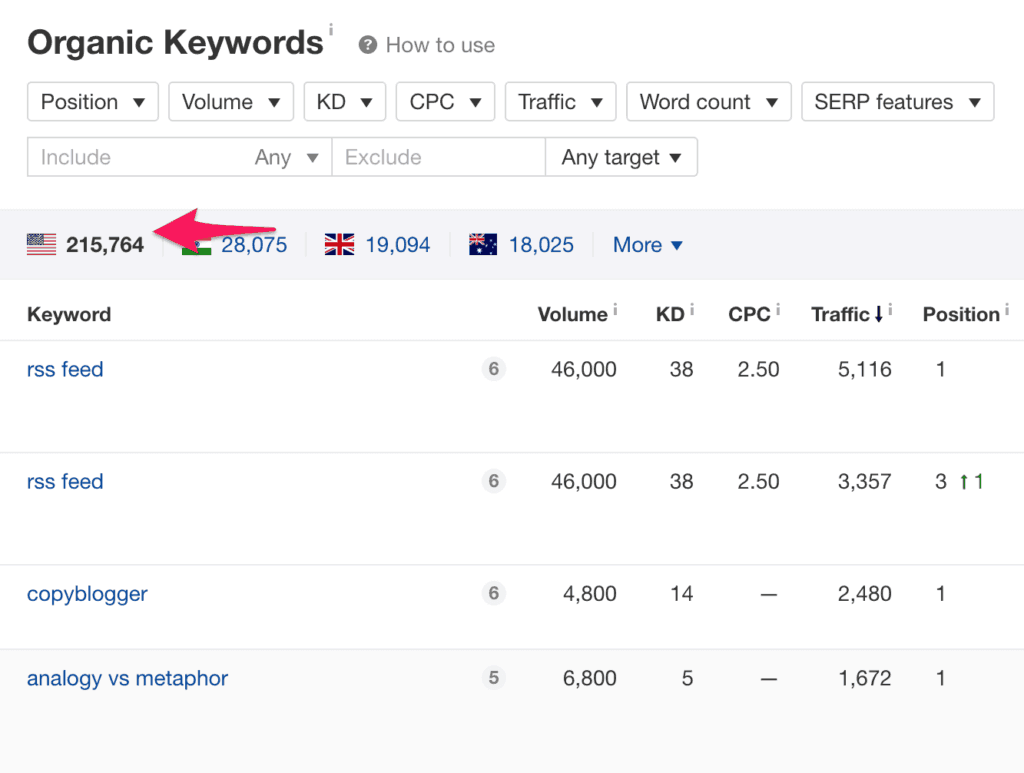
To cope with all of these keywords, segment by the keywords that rank in the top 20 results and have a volume above 1,000.
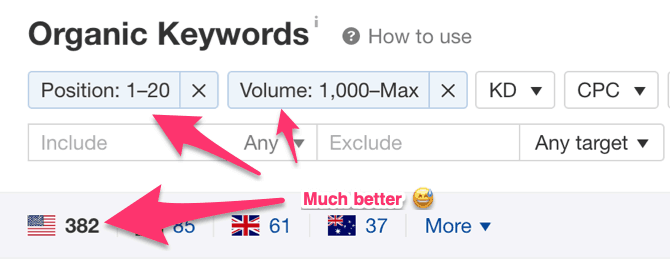
Export the results, and go through the keywords in Excel.
Just know that these aren’t content ideas, by the way, just their keywords. What’s more, many keywords come from the same page.
Also, high search volume doesn’t make a keyword great. Not even if its difficulty is low. What matter is relevancy; something that fits your brand, your audience, and your interests.
Take their keywords as inspiration, nothing more.
Brainstorm an Unlimited Stream of Interesting Topics to Write About
There will be a point in your writing career where you will feel like you no longer have interesting ideas to write about.
It’s common to write about tutorials or guides that help the reader achieve a certain goal.
But what if you want to take a different approach and write about something uniquely different?
I believe we all have dozens of interesting topics to write about. There are things you only know, experiences you have only experienced, ideas you have only thought about. If you could only realize that all of those things make you unique, then those could be topics you could write about.
Sometimes, it’s hard to uncover these ideas due to a belief that they don’t matter. Our educational system has taught us that we can only talk when we are asked to. So we dismiss our own creativity in favor of the wisdom of the crowd.
To break this creative blockage, I want you to bring back your inner child with a guided brainstorming session.
How to Run a Guided Brainstorming Session
If you are aware of the concept of brainstorming, the idea is that, within a predetermined block of time, you work to develop as many ideas as possible. Everything is possible; you don’t reject any ideas, you write them down as they come.
Brainstorming is a common technique in the creative world because it helps to find random but unique ideas to work with.
Most often, the typical brainstorming session consists of setting a 30-minute timer and thinking as many ideas as possible. The problem is that if you can’t seem to figure out what to write about, brainstorming won’t help you at all.
I’ve found a much easier and effective way to brainstorm content ideas, one where you can get “nudged” to find useful and relevant ideas. That’s why I’ve called it a “guided” brainstorming session; you guide your efforts into a specific part of the idea, then you mix and match to find unique and random ideas to write about.
To make this tactic work, I want you to first find a subject—the object on which you base your piece—and then an angle—the concept of the piece.
Grab a timer and set it up to 30 minutes. In the first brainstorming session, I want you to make a list of the following things:
- An influencer or expert you like.
- An influencer or expert you dislike.
- A historical person you like.
- A historical person you dislike.
- A company you like.
- A company you dislike.
- An employee (if you own a business or work for one).
- A colleague.
- A nonfiction book you like.
- A movie you like.
- A hobby you practice.
- A positive habit you have or used to have.
- A negative habit you have or used to have.
- A recent event from your industry.
- A recent event from the world.
- A historical event from your industry.
- A historical event from the world.
- A process (e.g., the “uberisation” of the economy).
- A trend.
- A potential threat in your industry.
- A potential threat in the world.
- A potential opportunity in your industry.
- A potential opportunity in the world.
- A hypothetical positive situation.
- A hypothetical negative situation.
- A problem you see in your industry.
- A problem you see in the world.
- A solution you propose to a problem you see in your industry.
- A solution you propose to a problem you see in the world.
After you are done, take a 15-minutes break. After it, set up another 30 minutes and brainstorm the angles you’d like to explore for each subject. Here are some ideas you may want to consider:
- The story of [the subject].
- A unique thing about [the subject].
- The teachings of [the subject].
- A letter to [the subject].
- A rant about [the subject].
- Your first experience with [the subject].
- What [the subject] did that surprised you.
- What you love about [the subject].
- What you hate about [the subject].
- Why you would change a specific aspect of [the subject]
- How [the subject] helped you with your personal life.
- How [the subject] helped you with your professional life.
- How [the subject] hurted your personal life.
- How [the subject] hursted your professional life.
- What if [the subject] did something different.
- Why you believe [the subject] is wrong about something.
- Why you believe [the subject] is right about something.
- How [the subject] has shaped an industry.
- The problem with [the subject].
The subject and angle can be anything you want it to be. As long as it connects to the basis of the article, any subject can work. If you find subjects and angles that I didn’t mention above, you can come up with your own ones.
To show you how this exercise looks like, I’ve done a quick brainstorming of five subjects. Here’s what I came up with:
- A business person: Peter Thiel.
- A solution: Focus on vocational education.
- A historical event: The fall of the Soviet Union.
- A process: Globalization.
- A book: The Meditations by Marcus Aurelius.
You can observe some of these subjects are specific—Peter Thiel—while others are broad—focus on technical education. One it’s even random, like the one about the fall of the Soviet Union. That’s on purpose.
Sometimes the best ideas are the ones that are broad in nature but specific in their diagnosis and potential resolution.
Also, the subjects are completely random. For example, I’ve read Conspiracy by Ryan Holiday, and I came to dislike Peter Thiel. But I dislike other business people as well—the Walton family is another example—so I could write about any of them. But Thiel is the main one that came to my mind.
With these subjects, I came up with the following random topics:
- How Peter Thiel Is Wrong about Globalization.
- How “The Meditations” Changed My Life.
- What I Would Change about “The Meditations”.
- What Would Happen If Peter Thiel Was Right.
- Why the Fall of the Soviet Union Was Bad for the World.
It’s important to remark that for each of these ideas I happen to have an idea which I could use in an article. I didn’t come up with these ideas randomly; the inputs are random, the ideas aren’t.
Even better, you could add multiple subjects to an article. For example, one subject could be a specific person while another subject could be a threat.
For example, I could write about “How Peter Thiel Is Wrong about Globalization.” Or whatever. Any mix of subjects with an angle could work—as long as it’s coherent.
With this framework, there’s an unlimited amount of random ideas you could come up with. You will have no reason to say you can’t come up with ideas to write about.
At the end of this brainstorming session, you will have an almost unlimited stream of interesting topics to write about for months.
Find Great Ideas to Write About: A Summary
So you’ve hit the end of this post.
With so much information in front of you, it’s time to get started.
Pick one of the tactics mentioned in this post, and implement it right away.
Then, I want you to comment below what your site is about and the writing ideas that you’ve developed.
If you want to get a summarized version of this post, then you can download the checklist below.
🎁 Free Bonus: Download the summarized version with the exact steps to learn how to find what things to write about.
